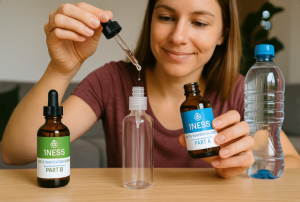Historically, mullein (Verbascum thapsus) has been valued for centuries across cultures—from ancient Europe to Traditional Chinese Medicine and Native American practices as a natural ally for respiratory health. With its tall stalk, soft leaves, and yellow flowers, this plant is well known for soothing the lungs, clearing mucus, and making breathing easier. As more people turn to natural remedies, mullein continues to stand out as a gentle yet effective option for supporting respiratory wellness.
What Is Mullein?
Mullein is a biennial plant that comes from Europe, Asia, and North Africa. In its first year, it grows a rosette of large, fuzzy leaves. By the second year, it develops a tall stalk topped with bright yellow flowers. Traditionally, people have used mullein in teas, tinctures, and poultices to support respiratory issues like bronchitis, asthma, and sore throats.
Its key properties include:
- Expectorant action to help clear mucus
- Anti-inflammatory effects to soothe irritated airways
- Mild antimicrobial activity to support immune defenses
Today, mullein remains a popular choice for those seeking natural ways to detoxify the lungs and enhance respiratory health.
How Mullein Supports Lung Detox
1. Expectorant Properties
To begin with, mullein helps loosen and thin mucus, making it easier to expel from the lungs. This can improve breathing and reduce airway blockages, particularly beneficial for conditions like chronic bronchitis.
2. Anti-Inflammatory Effects
In addition, the mucilage in mullein coats and soothes mucous membranes, helping calm irritation caused by infections, pollutants, or smoke exposure. This may reduce coughing, wheezing, and general discomfort.
3. Antimicrobial Activity
Moreover, mullein contains natural compounds that can fight bacteria and viruses. Research shows potential effectiveness against pathogens like Staphylococcus aureus, Escherichia coli, and even some flu viruses. This supports its traditional use in fighting respiratory infections.
Mullein for Common Respiratory Conditions
- For instance, in asthma, mullein’s anti-inflammatory and expectorant effects can ease inflammation…
- Bronchitis: It soothes irritated bronchial passages and aids in clearing mucus, while its antimicrobial properties may help fight infection.
- COPD: For chronic obstructive pulmonary disease, mullein may assist in managing mucus buildup and inflammation, supporting clearer airways.
Hydration, Lung Health, and the Gut-Lung Connection
Additionally, hydration is essential for lung detox. Drinking enough water helps thin mucus, making it easier to clear toxins and debris from the respiratory tract. This also supports the gut-brain-lung axis, as proper hydration aids digestion, bowel regularity, and immune balance—further benefiting respiratory wellness.
How to Use Mullein
Mullein can be incorporated into your routine in various forms:
- Tea: Steep dried mullein leaves (strain well to remove fine hairs) for a soothing drink that supports the lungs.
- Tincture: Convenient and concentrated, mullein tincture can be taken daily for consistent support.
- Capsules or supplements: Great for those who prefer an easy, tasteless option.
For best results, use mullein consistently and pair it with healthy habits like hydration, balanced nutrition, and avoiding environmental irritants.
Final Thoughts
In conclusion, mullein is a time-tested herb that offers a gentle, natural way to detoxify the lungs and support overall respiratory health. With its ability to loosen mucus, soothe inflammation, and provide mild antimicrobial action, mullein remains a trusted choice for those seeking holistic lung care.
If you’re looking to incorporate mullein into your wellness routine, explore high-quality options like teas, tinctures, or supplements and always consult your healthcare provider if you have underlying conditions or are on medication.





